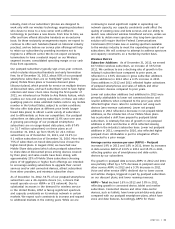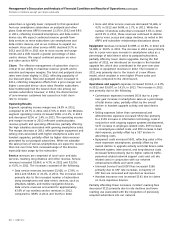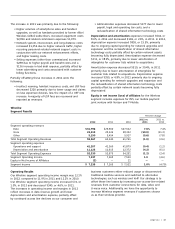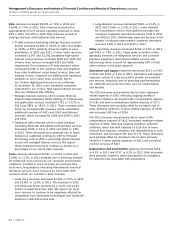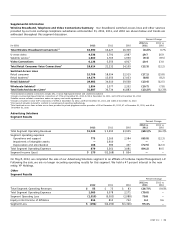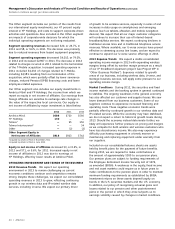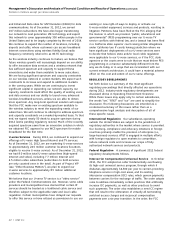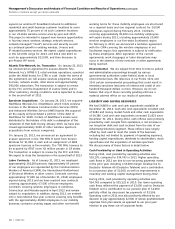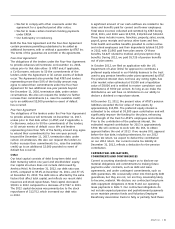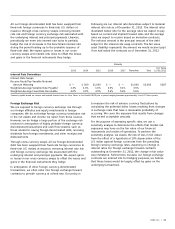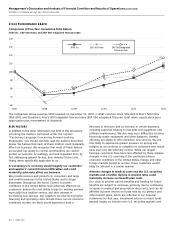AT&T Wireless 2012 Annual Report Download - page 46
Download and view the complete annual report
Please find page 46 of the 2012 AT&T Wireless annual report below. You can navigate through the pages in the report by either clicking on the pages listed below, or by using the keyword search tool below to find specific information within the annual report.
Management’s Discussion and Analysis of Financial Condition and Results of Operations (continued)
Dollars in millions except per share amounts
44 | AT&T Inc.
taking into account current collection trends as well as
general economic factors, including bankruptcy rates.
Credit risks are assessed based on historical write-offs,
net of recoveries, and an analysis of the aged accounts
receivable balances with reserves generally increasing as
the receivable ages. Accounts receivable may be fully
reserved for when specific collection issues are known
to exist, such as pending bankruptcy or catastrophes.
The analysis of receivables is performed monthly, and
the allowances for doubtful accounts are adjusted through
expense accordingly. A 10% change in the amounts
estimated to be uncollectible would result in a change
in the provision for uncollectible accounts of
approximately $112.
Pension and Postretirement Benefits Our actuarial
estimates of retiree benefit expense and the associated
significant weighted-average assumptions are discussed
in Note 11. Our assumed discount rate of 4.30% at
December 31, 2012, reflects the hypothetical rate at which
the projected benefit obligations could be effectively
settled or paid out to participants. We determined our
discount rate based on a range of factors, including a yield
curve composed of the rates of return on several hundred
high-quality, fixed income corporate bonds available at the
measurement date and the related expected duration for
the obligations. These bonds were all rated at least Aa3 or
AA- by one of the nationally recognized statistical rating
organizations, denominated in U.S. dollars, and neither
callable, convertible nor index linked. For the year ended
December 31, 2012, we decreased our discount rate by
1.00%, resulting in an increase in our pension plan benefit
obligation of $7,030 and an increase in our postretirement
benefit obligation of $4,546. For the year ended
December 31, 2011, we decreased our discount rate
by 0.50%, resulting in an increase in our pension plan
benefit obligation of $3,384 and an increase in our
postretirement benefit obligation of $2,114.
Our expected long-term rate of return on plan
assets assumption was 8.25% for the year ended
December 31, 2012. In 2013, due to the continued
uncertainty in the securities markets, the U.S. economy
and the plans’ asset mix, we have lowered our expected
long-term rate of return on plan assets to 7.75%. Our
expected return on plan assets is calculated using the
actual fair value of plan assets. If all other factors were
to remain unchanged, we expect that a 0.50% decrease
in the actual long-term rate of return would cause 2013
combined pension and postretirement cost to increase
$260, which under our accounting policy would be
recognized in the current year as part of our fourth-
quarter remeasurement of our retiree benefit plans.
We recognize actual gains and losses on pension and
postretirement plan assets immediately in our operating
results. These gains and losses are generally measured
annually as of December 31 and accordingly will normally
services or to rate-of-return requirements; or adopt a
regulatory framework that incorporates deregulation and
price caps. Some states may impose minimum customer
service standards with required payments if we fail to meet
the standards.
We continue to lose access lines due to competitors
(e.g., wireless, cable and VoIP providers) who can provide
comparable services at lower prices because they are not
subject to traditional telephone industry regulation (or the
extent of regulation is in dispute), utilize different technologies,
or promote a different business model (such as advertising
based) and consequently have lower cost structures.
In response to these competitive pressures, for several years
we have utilized a bundling strategy that rewards customers
who consolidate their services (e.g., long-distance telephone,
high-speed Internet, wireless and video) with us. We continue
to focus on bundling wireline and wireless services, including
combined packages of minutes and video service through our
U-verse service and our relationships with satellite television
providers. We will continue to develop innovative products
that capitalize on our IP-based network (e.g., see Project VIP
in “Other Business Matters”).
Additionally, we provide local, domestic intrastate and
interstate, international wholesale networking capacity, and
switched services to other service providers, primarily large
Internet Service Providers using the largest class of
nationwide Internet networks (Internet backbone), wireless
carriers, Competitive Local Exchange Carriers, regional phone
Incumbent Local Exchange Carriers, cable companies and
systems integrators. These services are subject to additional
competitive pressures from the development of new
technologies and the increased availability of domestic and
international transmission capacity. The introduction of new
products and service offerings and increasing satellite,
wireless, fiber-optic and cable transmission capacity for
services similar to those provided by us continues to provide
competitive pressures. We face a number of international
competitors, including Orange Business Services, British
Telecom, SingTel and Verizon Communications Inc., as well
as competition from a number of large systems integrators,
such as HP Enterprise Services.
ACCOUNTING POLICIES AND STANDARDS
Critical Accounting Policies and Estimates Because of the
size of the financial statement line items they relate to or the
extent of judgment required by our management, some of
our accounting policies and estimates have a more significant
impact on our financial statements than others. The following
policies are presented in the order in which the topics appear
in our consolidated statements of income.
Allowance for Doubtful Accounts We maintain an
allowance for doubtful accounts for estimated losses that
result from the failure of our customers to make required
payments. When determining the allowance, we consider
the probability of recoverability based on past experience,



